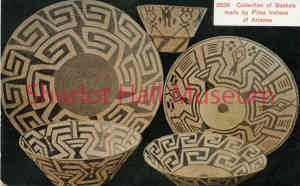Pima Indian Woven Baskets
details
Unknown Adolph Selige, Publishing Company, St. Louis - Leipzig inpi1306pa.jpg IN-PI-1306 Color 1507-1306-0001 inpi1306pa Postcard 3x5 Historic Photographs 1900s Reproduction requires permission. Digital images property of SHM Library & ArchivesDescription
Baskets are one of the oldest forms of storage and transportation of food and water. Grass was one of the most abundant natural materials available for basket making. Many baskets, particularly in the Southwest, were also constructed of yucca fibers, corn husks and willow.
Basketry began in the Southwest during the late Archaic Age (ca. 1800 b.c.e.). It was during this period that the cultures commonly referred to as Basket maker arose. These people were believed to have been the ancestors of the Anasazi and Mogollon.
Descendants of these cultures who excelled in basketry include the Akimel O'Odham (Pima), Tohono O'odham (Papago), and Hopi. The Apache and Dine (Navajo), who later settled in this region, became excellent basket makers as well.
There are three basic techniques involved in basketry. The earliest known is "twining", where the wefts or moving elements twist around the foundation elements or warps. Next is "coiling", where the base element is coiled and held in place by the warping element. Thirdly, is "plaiting", with the warps and wefts woven over and under each other in a particular pattern.
The Pima are well-known for their finely made coiled willow basketry. Because of their close proximity to the river, the Pima were able to harvest great quantities of willow to make their baskets. Basket foundations were often made of local grasses or cattail and strips of devil’s claw (martynia) was used for the design elements. Baskets were generally woven with squash blossom, geometric fretwork or whirling wind designs, while some weavers used figurative images of humans and animals on occasion. The basket starts are made with devil’s claw and the rim was finished with a traditional herringbone weave. In early years, the Pima also wove large storage baskets made of wheat straw for storing their grains.
Purchase
To purchase this image please click on the NOTIFY US button and we will contact you with details
The process for online purchase of usage rights to this digital image is under development. To order this image, CLICK HERE to send an email request for details. Refer to the ‘Usage Terms & Conditions’ page for specific information. A signed “Permission for Use” contract must be completed and returned. Written permission from Sharlot Hall Museum is required to publish, display, or reproduce in any form whatsoever, including all types of electronic media including, but not limited to online sources, websites, Facebook Twitter, or eBooks. Digital files of images, text, sound or audio/visual recordings, or moving images remain the property of Sharlot Hall Museum, and may not be copied, modified, redistributed, resold nor deposited with another institution. Sharlot Hall Museum reserves the right to refuse reproduction of any of its materials, and to impose such conditions as it may deem appropriate. For certain scenarios, the price for personal usage of the digital content is minimal; CLICK HERE to download the specific form for personal usage. For additional information, contact the Museum Library & Archives at 928-445-3122 ext. 14 or email: orderdesk@sharlot.org.




